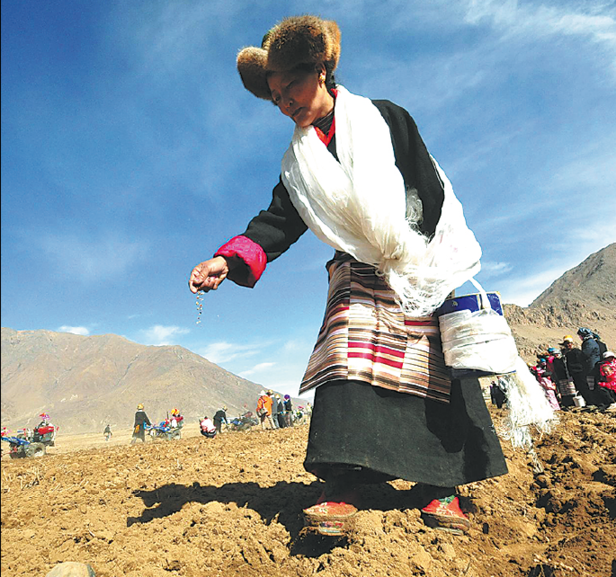Barley provides health, chance to grow an industry
 |
|
A Tibetan farmer sows highland barley seeds at her farm and expects a good harvest in the coming season. ZHAO GUANSHEN / FOR CHINA DAILY |
Highland barley farming is expected to become an important way for farmers in the Tibet autonomous region to get rich, as the industry has been extended to include deep processing and more related sectors, local agricultural officials and experts say.
The region's agricultural research institutions have developed more than 60 finished products based on highland barley, the local agricultural administration said.
More than 30 companies in Tibet are engaged in processing highland barley, with a designed capacity of about 110,000 metric tons. About 60,000 tons of highland barley was processed into various finished products last year, the Tibet Agriculture Bureau said.
Highland barley, known as qingke among locals, has been the most important crop and the staple food ingredient in Tibet for thousands of years.
Output increased from 621,800 tons in 2011 to 746,700 tons last year, according to official figures. Local officials and experts predict output will reach 800,000 tons in 2020, with the planting area expected to surpass 133,000 hectares.
Highland barley is traditionally used to make zanba, or roasted barley flour, or wine. Because of its rich protein, fiber and vitamin content and low fat and sugar content, highland barley can be used to make many more healthy food and beverage products.
The Tibet Bureau of Science and Technology has offered strong support for the industrialization of highland barley. It spent nearly 10 million yuan ($1.5 million) in developing highland barley-based products last year.
The bureau partnered with more than 20 research and educational institutions in Tibet and the rest of the country, including the Chinese Academy of Agricultural Sciences, China Agricultural University and the Chinese Academy of Sciences, developing more than 40 barley-based products last year.
Nyima Tsering, president of the Tibet Academy of Agricultural Sciences, said the autonomous region will focus its efforts on upgrading existing enterprises in the farming product processing sector using modern technologies.
These companies will be encouraged to develop multifunctional and high value-added products based on highland barley to meet demand, Nyima Tsering said.
Traditional highland barley producing regions such as Xigaze, Qamdo, Lhasa and Shannan will be the major regions for barley deep processing, he said.
"By implementing supply-side reforms and promoting the use of advanced farming and processing technologies, the highland barley-related industries are expected to bring in 50 billion yuan worth of revenue for Tibet a year," Nyima Tsering said.
People's Daily contributed to the story.









